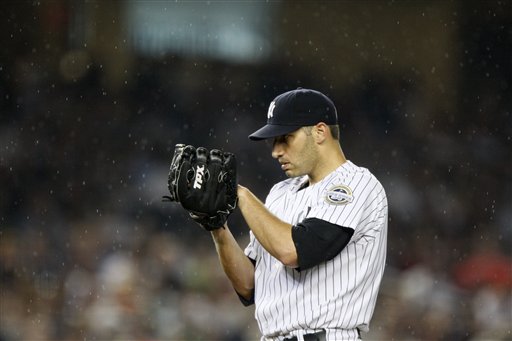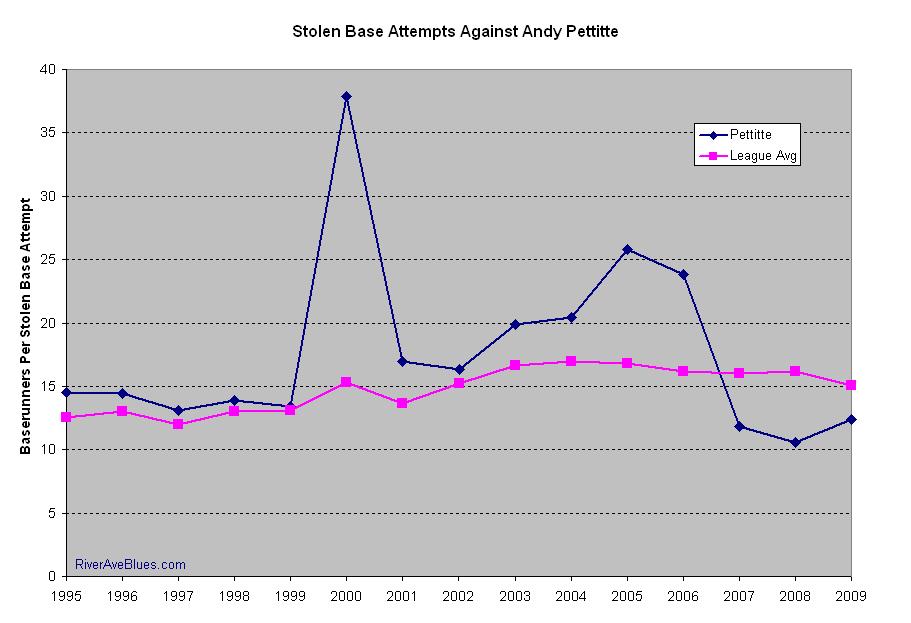Ah the pickoff. There’s nothing in baseball quite like it. When one of the good guys catches a runner napping and picks him off, there’s that rush of excitement that comes with stealing an out. At the same time, there’s almost nothing in the game more frustrating than watching one of your guys get picked off. I wanted to take a look at how often opponents were swiping bases (or tried to, anyway) against Yankee pitchers last year, but frankly the data was pretty boring and consistent with past seasons for everyone on the team who accumulated a usable sample of innings. Except for one guy, that is: Andy Pettitte.
In terms of stolen base attempts, Andy is a unique case. He’s a lefty, which has its own built-in advantage, and of course he has that great pickoff move. If you’re any kind of Yankee fan, you know that Pettitte’s move to first is world class, and if it’s not the best in the game, then it’s definitely in consideration for it. Pickoffs serve two purposes, the first obviously is trying to steal an out when a guy is napping. But throws to first also serve to hold runners close, muting the running game.
Unfortunately there’s no perfect way to measure a pitcher’s ability to hold runners … well, maybe there is and I’m just not aware of it. Anyway, because of this I’ll stick to the basics and look at how often opponents have attempted to steal bases off Andy throughout his career. We generally break stats down in terms of innings pitched for pitchers (K/9, BB/9, WHIP, etc); however, for this exercise I broke the data down using baserunners because all innings are not created equal. You can’t steal a base unless you first reach base, so looking at it any other way just wouldn’t make sense. The bigger the number the better, since that means more runners have to reach base before someone attempts to steal a bag. Here’s the raw data table (the second BR/SBA column is the league average, I forgot to label it), and the plot is below. Click to enlarge.
First off, elephant in the room, that 2000 season. I double checked the data, and for whatever reason baserunners just did not attempt to steal against Pettitte that season. Just eight (!!!) stolen base attempts by 303 baserunners in over 200 innings, and that includes the three guys he picked off. It wasn’t even one of Pettitte’s best years either. Yeah, he finished fourth in the Cy Young voting on the strength of 19 wins, but he had a 4.35 ERA (4.22 FIP) and a below average 1.56 K/BB ratio. Statistical outlier, I suppose.
As for the rest of the data, it passes the sniff test. Baserunners attempted to steal bases at a slightly lower than league average rate for the first four years of Pettitte’s career, and after that crazy 2000 spike they attempted to swipe bags at an even lower rate. Once Andy got to Houston (’04-’06), it’s like they just stopped trying. We’re talking more than 20 baserunners for every one stolen base attempt. However, things changed once Pettitte returned to the Bronx.
Since coming back to the Yankees in 2007, opponents have been far more liberal on the bases against Pettitte than at any other time in his career. In fact, they’re the only three years of his 15-year career in which runners tried to steal bases at a rate higher than league average against the big lefty. The knee-jerk reaction is to blame the throwing and defensive deficiencies of Jorge Posada, but note that baserunners attempted steals at the highest rate of Pettitte’s career in 2008, when Posada was hurt and caught less than 25% of his innings.
I have no idea what is causing this, and I don’t have the tools to find out, either. It’s more than a matter of just looking at some numbers given the uniqueness of stolen bases and holding runners. Maybe after a dozen years in the bigs, the league finally caught on to Andy’s pickoff move and runners have learned when to pick their spots. Maybe it’s advancements in technology and scouting. Maybe it is Posada’s arm, who knows. For whatever reason, baserunners who reach base against Pettitte are trying to steal bases more often than ever before. Any theories?
Photo Credit: Kathy Willens, AP


Leave a Reply
You must be logged in to post a comment.